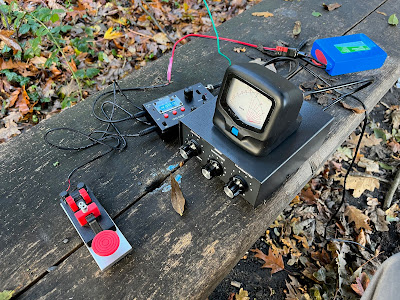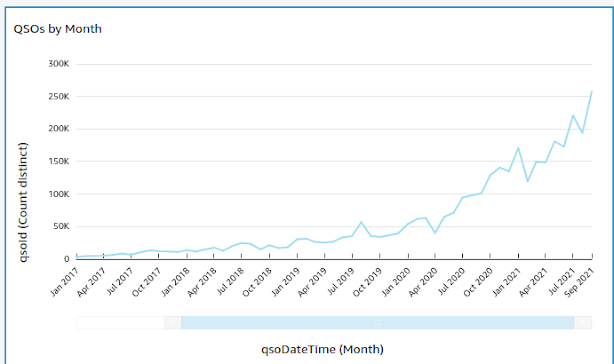Best. Activation. Ever.
Let's get this out of the way first. It was the most challenging Parks on the Air (POTA) activation I've ever done. Challenging to the point of unpleasant—dare I say, pain in the ass. For starters, it took an inordinate amount of time to find a combination of antenna and tuner setup that would get the SWR under 3. Once I got on the air, responses to my QRP CQs were slow in coming, so much so that I was facing the very real possibility that darkness or a dead battery would set in before I reached the requisite ten contacts. After a few contacts, I noticed that my lightweight, entry-level straight key that I take with me on backpack-portable activations felt funny. I took a closer look at the key and realized that a stress fracture had developed in the arm between the tension spring and the contacts. What was making my key return when I eased up between dots and dashes was not the tension spring, but the memory in the arm, its tendency to return to its original molded shape after being deformed by the pressure of my fingers on the knob. A couple more QSOs and the unthinkable happened. The stress fracture widened and broke completely through, leaving only the wire running to the arm-side contact holding it all together. I was a long way from home, a long way from the nearest HRO, and a long way from a successful activation.
The park was Waggelwaterbos, or Waggelwater National Forest, ON-0374, in Belgium. I was on family holiday, exploring Amsterdam and Bruges. The park is a 7 hectare (about 17 acres) tract of wooded land surrounded on all sides by the town of Bruges. In the US, the relatively small size and proximity to an urban area would likely have made such a place a city park or a county regional park. In the nomenclature of Belgian public lands, these bits of preserved woodlands are considered national forests, and therefore, they count as POTA entities.
To make the wounded code key work and to stay on the air, I worked out an improvised technique. Gripping the key with the thumb, middle, and ring fingers of my right hand, I applied forward pressure, holding the broken-off portion of the arm tightly against the portion that remained attached to the pivot point and tension spring. I actuated the key by pressing on the top of the arm's broken-off section with my index finger. The traction created by the forward pressure that I was maintaining made the good part of the arm move with the broken-off part (which still had one of the two contacts), giving me a little feedback between dots and dashes from the tension spring. It took a little practice and a lot of effort, but I was able to send with a fist that was readable, if not exactly solid. With time and patience, I made it to ten contacts, tore down the setup, and drove back to our Airbnb in the town's old section to enjoy pizza and a Zot beer with the family.
Despite the challenges, the activation of Waggelwaterbos turned out to be my favorite activation yet. To get into why, we'll need to go into a little background on my approach to activating, which I strongly suspect is not a unique approach.
I don't consider activating to be a God-given right. I don't use amateur radio's (diminishing) role in emergency communications as justification for being in the park. I avoid acting like I own the place, even though as a taxpaying citizen I do, in a manner of speaking. (That's at least true in the case of California state parks and US federal lands, more on that distinction later.) I consider myself to be another park visitor—no more, no less—one of anywhere from dozens to thousands of park visitors on that particular day, depending on the size and popularity of the park. I'm there for the same reason as any other park visitor: to enjoy my chosen activity in the outdoors. Ideally, I'd like to enjoy that activity with as little friction as possible; I certainly would prefer that I could enjoy it without someone calling the cops on me. Yet I'm also keenly aware that there are other park visitors who all want to enjoy their activities in a relatively frictionless way too. So I stay away from high-traffic portions of the park. I don't run cables across walkways. I take up, at most, one picnic table. I put a ham stick on top of my car if I think a wire antenna is going to be problematic. If there's an expectation of peace and quiet, I wear headphones. Most importantly, I try to be friendly toward curious fellow park visitors and cooperative with park rangers. Nearly half a century ago, long before we all got so good at calling each other names, I was taught that such consideration for the other guy or gal was just good manners.
Operating in a foreign country was going to put all that consideration for other stakeholders to the test. Sure, the legal aspects of operating in Belgium with a US license were pretty straightforward, and the Royal Belgian Amateur Radio Union go out of their way to make visiting hams feel welcome, but there was much about the local customs and preferences that were unknowns. How would I be viewed by fellow park visitors? Would the presence of me and my gear be seen as an intrusion in this peaceful wooded area? This was their park. This was their country. I was the guest. Any adverse interaction with a local would throw into serious question the appropriateness of my being there.
Over the couple hours I was there, about a half dozen people passed by, walking the paths that wound through the woods. Two stopped and asked what I was doing. The two conversations were almost identical.
"I'm an amateur radio operator. I'm making contact with other amateur radio operators all over Europe. So far I've talked to Italy, Austria, Hungary. . . ."
"Is this a better place for radio?"
"It can be. Getting a little distance away from all the cars and trains and solar panels and other sources of electrical noise, it can be easier to hear. But mostly I'm here because I participate in a program called Parks on the Air that encourages amateur radio operators to operate outdoors in state parks, national parks, national forests."
"Well, this is a national forest."
"Yes, and it's beautiful here."
"How do you talk to people so far away?"
"The upper atmosphere is electrically charged, from being hit by the sun's radiation. On the frequencies we use, the interaction of the radio energy and that electrically charged air bends the radio signal back toward the ground and you can talk well past the horizon—thousands of kilometers."
"That's so cool! Good luck."
"Thanks. Nice meeting you."
Far from being suspicious or judgemental, the two people I met that day were warm and friendly and showed a genuine enthusiasm for what I had to share about this radio thing. I'm grateful to the ten operators who made the activation a success, but it's the two eyeball QSOs with people who call Belgium home and who know Waggelwaterbos as well as I know Chino Hills State Park that made my first activation outside my home country unforgettable. Bedankt!








Comments
Post a Comment